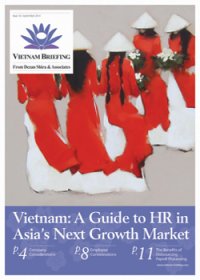McKinsey Sees Room for ASEAN Improvement and Future Growth
In its recent report on achieving sustained economic growth in Southeast Asia, the global management consulting firm, McKinsey, highlighted key areas for improvement in ASEAN, particularly the need to improve labor productivity, which still remains low.
Rising manufacturing costs in China have meant that business has been steadily moving to cheaper ASEAN countries for some time now. The chief concern for many businesses has been the level of labor productivity in the region, which has been frequently criticized for being drastically lower than in China. On average labor productivity in Vietnam’s manufacturing sector is only about seven percent of that in China. Clearly, this must be addressed if ASEAN is to take advantage of this shift and capture a greater share of global manufacturing. Countries like Thailand have managed to be somewhat more competitive – though still fairly low, its labor productivity is 37 percent that of China, this is significantly higher than other countries in the region. Thailand also has much higher labor force participation than neighboring countries.
While variations in standards and regulations between countries in the region continue to limit intra-ASEAN trade, integration is proceeding faster for traded goods, particularly in textiles, wood, and the automotive industry. The latter is particularly good news for Thailand and Malaysia who are becoming increasingly respected exporters of major vehicle and automotive-parts.
RELATED: Myanmar Hosts 25th ASEAN Summit
The dream of the “ASEAN car”, with all parts produced and assembled in the region, was first floated in the 1980s and resurfaced last month when Malaysian Prime Minister, Najib Razak announced plans to launch a feasibility study in conjunction with Indonesia. The idea is appealing: ASEAN is the world’s fifth largest car market. But this campaign is also a positive signal for foreign investors in the automotive industry. However, McKinsey’s report emphasizes restrictions to foreign investment and ownership continue to act as trade barriers to the region.
Another key area of improvement for ASEAN is in their deployment of disruptive technologies, which are poised to create substantial economic growth: mobile internet, big data, the automation of knowledge work, cloud technology, and the internet of things. McKinsey calculates these five disruptive technologies have the potential to unleash some US$220 billion and to US$625 billion in annual economic impact by 2030.
These technological advances will help companies move quickly to digitize their operations and establish competitive positions. Thailand is forging ahead in the internet of things, which involves digital tracking to check efficiency, supply chains, and avoid excess inventory. Its water authority, for instance, has already implemented a system to consolidate data across all of its regional water systems to track supply, losses, customer use, and water levels during flooding.
It remains to be seen how ASEAN will incorporate all of these areas into its future economy, but it seems clear that the region is committed to continuing to make itself more competitive and ensure that it has an attractive business environment not only just for local businesses but also for global investors seeking to take advantage of this dynamic region. To learn more about the opportunities available in the ASEAN region for your business, please contact Dezan Shira & Associates.
Asia Briefing Ltd. is a subsidiary of Dezan Shira & Associates. Dezan Shira is a specialist foreign direct investment practice, providing corporate establishment, business advisory, tax advisory and compliance, accounting, payroll, due diligence and financial review services to multinationals investing in China, Hong Kong, India, Vietnam, Singapore and the rest of ASEAN. For further information, please email asean@dezshira.com or visit www.dezshira.com.
Stay up to date with the latest business and investment trends in Asia by subscribing to our complimentary update service featuring news, commentary and regulatory insight.
Related Reading
 Tax, Accounting, and Audit in Vietnam 2014-2015
Tax, Accounting, and Audit in Vietnam 2014-2015
The first edition of Tax, Accounting, and Audit in Vietnam, published in 2014, offers a comprehensive overview of the major taxes foreign investors are likely to encounter when establishing or operating a business in Vietnam, as well as other tax-relevant obligations. This concise, detailed, yet pragmatic guide is ideal for CFOs, compliance officers and heads of accounting who need to be able to navigate the complex tax and accounting landscape in Vietnam in order to effectively manage and strategically plan their Vietnam operations.
 An Introduction to Tax Treaties Throughout Asia
An Introduction to Tax Treaties Throughout Asia
In this issue of Asia Briefing Magazine, we take a look at the various types of trade and tax treaties that exist between Asian nations. These include bilateral investment treaties, double tax treaties and free trade agreements – all of which directly affect businesses operating in Asia.
 Vietnam: A Guide to HR in Asia’s Next Growth Market
Vietnam: A Guide to HR in Asia’s Next Growth Market
In this issue of Vietnam Briefing, we attempt to clarify human resources (HR) and payroll processes in Vietnam. We first take you through the current trends affecting the HR landscape and then we delve into the process of hiring and paying your employees. We next look at what specific obligations an employer has to their employees. Additionally, we guide you through the often complex system of visas, work permits, and temporary residence cards. Finally, we highlight the benefits of outsourcing your payroll to a “pan-Asia” vendor.
- Previous Article Myanmar Hosts 25th ASEAN Summit
- Next Article Thai Economy Sees Improvement Due to Increased ASEAN Integration









